Caterpillars
Butterflies
Moths
- Forest Tent Caterpillar
- Azalea Caterpillar
- Yellowstriped Oakworm
- Tomato Hornworm
- Hickory Horned Devil
- Luna Moth Caterpillar
Cloudless Sulphur Caterpillar
This caterpillar is 1-1/2″ to 2″ long when fully developed. It has a pebbly surface and bears a distinct lateral yellow stripe running the length of the body. Larvae feed on Cassia spp., favoring sicklepod and partridge pea.'
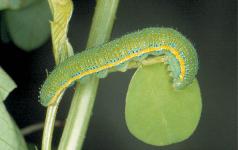
Giant Swallowtail Caterpillar
This caterpillar is 1-1/2″ to 2″ long when mature and has a blotchy brown-and-white pattern. It looks remarkably like a bird dropping throughout its larval stages. These caterpillars feed primarily on citrus and are called “orange dogs” because they are commonly found in orange groves.
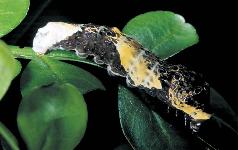
Gulf Fritillary Caterpillar
This caterpillar is 1-1/4″ to 1-3/4″ at maturity and has an orange body with several rows of black spines along the entire length. The food plant is passion vine, and it lays its eggs on or near any part of the plant.
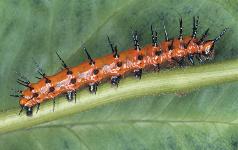
Longtailed Skipper Caterpillar
This caterpillar, known as the bean leafroller, is commonly found on different varieties of beans. Other legumes also serve as food plants, including wisteria and hairy indigo. The distinctive caterpillar is 1″ to 1-1/2″ long and has a large brown, rounded head. The body is light-green with parallel yellow lines down the back.
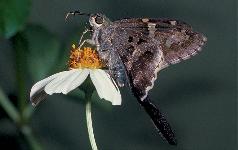
Zebra Longwing Caterpillar
This caterpillar reaches a length of 1-1/2″ to 1-3/4″. It has white above and brown below, with several rows of black spines that run the entire length of the body, interspersed with black spots. The eggs are laid on the new growth of passion vines, which serve as the larval food plant.
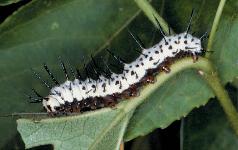
Forest Tent Caterpillar
Larvae have a dark-gray to brownish-black background body color, highlighted by broad, pale- blue lines and thin, broken yellow lines extending along each side. On the dorsum of each abdominal segment is a distinct, whitish keyhole or shoeprint-shaped marking. Larvae are also somewhat hairy, the setae being fine, whitish in color, and sparsely distributed. Mature larvae are 2 to 2.5 in. (50 to 64 mm) in length. Pupation occurs in a pale- yellow, loosely spun silken cocoon. The stout-bodied adult moths are tan to buff-brown in color, with two darker, thin parallel lines extending across the mid-portion of each forewing, the area between often being dark and appearing as a single, broad, dark band. The wingspread ranges from 1 to 1 3/4 in. (25-45 mm). Eggs occur in masses of 100 to 350, forming bands up to 1 in. (25 mm) in length that encircle small diameter twigs. Egg masses are coated with a dark-brown, frothy, cement-like substance called spumaline.
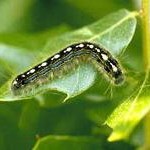
Azalea Caterpillar
Young caterpillars feed in a cluster side by side unless disturbed. These first instar caterpillars are approximately 3/8 inch long after feeding for eight to ten hours. They remain gregarious and soon devour the entire leaf.
As the larva matures, it becomes highly colored. The mature caterpillar is yellow with seven red longitudinal stripes and a black head. Now the caterpillar is about two inches long, and predominately black, with a red last segment and eight broken yellow (occasionally white) lengthwise stripes. The head and legs are mahogany-red.
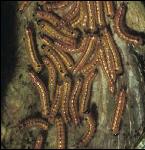
Yellowstriped Oakworm
The first stage caterpillars are yellow with a black head and two prominent horns rising from the second thoracic segment. The second stage caterpillars retain the yellow to yellow-green color and are slightly larger. During the third and fourth stages, the caterpillars change from yellow, to yellow-green, to a black. Eventually, larvae become black-bodied with yellow stripes running along their sides. Fully-grown larvae may be 2 inches (50 mm) long. All have the black coloration with yellow stripes, prominent black horns arising from the second thoracic segment, and a row of small spines running along the body behind each of the horns.
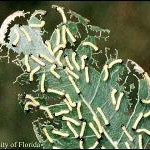
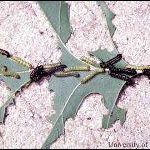
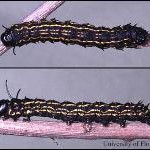
Tomato Hornworm Caterpillar
The Tomato Hornworm larva is cylindrical in form, and bears five pairs of prolegs in addition to three pairs of thoracic legs. The most striking feature of the larva is a thick pointed structure or “horn,” located dorsally on the terminal abdominal segment.
The tomato hornworm bears eight whitish or yellowish “V”-shaped marks laterally, and pointing anteriorly. The “V”-shaped marks are not edged in black. Also, in tomato hornworm the “horn” tends to be black in color. Larval development time averages about 20 days.
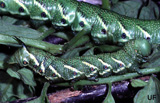
Hickory Horned Devil
The hickory horned devil is among the largest of our native saturniid caterpillars. It is 12.5 to 14 cm in length – about the size of a hot dog. The caterpillars vary slightly in color, but are commonly blue-green. The second and third thoracic segments each bear two long and two shorter orange, black-tipped scoli (tubercles in the form of spinose projections of the body wall). The abdominal segments each have four short, black scoli, and segments 2 through 8 have a pale, oblique lateral stripe. Although the larva has a fierce appearance, it is harmless, and becomes a beautiful regal moth.
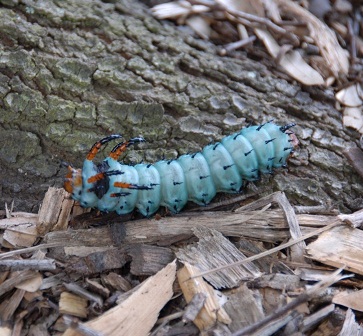
Luna Moth Caterpillar
These bright green full-grown caterpillars are 55 to 70 mm in length. There is a yellowish-white sub-spiracle line on abdominal segments one through seven and posterior yellow lines extending across the dorsum of segments one through seven to just above the level of the spiracles.
A mid-segmental transverse band of setae-bearing scoli occurs on all thoracic segments and abdominal segments one through eight. The body is sparsely covered with short, white, spatulate setae. The head varies from green to brown. Just prior to pupation, caterpillars turn a reddish color.
Early instars differ considerably in appearance from the later instars. Some fifth instars are considerably more setiferous (hairy) than others even among siblings.
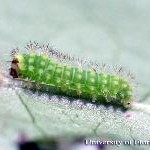
Contact
Wakulla County Extension Address
84 Cedar Avenue
Crawfordville, FL 32327
Hours
Monday - Friday
8:00am – 5pm
Samantha Kennedy
UF/IFAS Wakulla County Extension Director & FCS Agent
Phone (850) 926-3931
skennedy@ufl.edu

